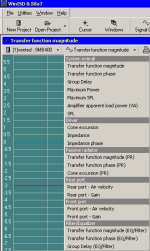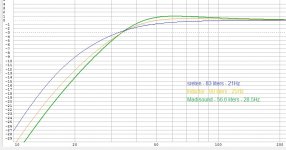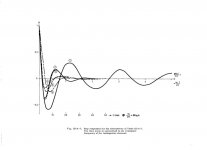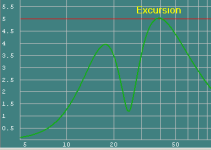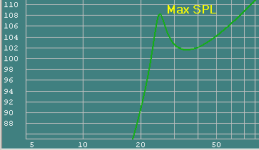Originally Posted by Richidoo
Thanks Zero D for helping me.....
Pleasure ! The power rating of that driver is rated DIN, not RMS. You really don't want to be going anywhere near Xmax, if you like undistorted bass.
With my old copy of WinISD v.50a7 i can view etc those details. which V did you use originally ?
Does one 4" x 24" pipe sound better than two 2" x 12" pipes with same mach number?
You could always internally use a 90 etc degree angle piece, & join two lengths together. Make sure the center line through the total pipe lengths = calculated length.
Attachments
Last edited:
Very right.
For now just measure internal correct "calibrated" dimension for the diameter for the 4" and 3" pipes. And for the record (you already mentioned 24" lengths) their max. lengths for a good simulation.
3" pipe is actually 3.05" avg. dia.
4" pipe is actually 3.99" avg. dia. Measured with .001 calipers
The pipes are available locally in 24" lengths, but I can buy an 8 foot length if the design calls for it. It is OK for the port to extend beyond the exterior of the box.
Pleasure ! The power rating of that driver is rated DIN, not RMS. You really don't want to be going anywhere near Xmax, if you like undistorted bass.
I didn't see that was DIN. Yes, low excursion = low distortion. I assumed that the port will limit excursion at resonance, but apparently less so with EBS.
With my old copy of WinISD v.50a7 i can view etc those details. which V did you use originally ?
Until today, I have been using WinISD Beta, ver 0.44, from 2002. It does not plot power or excursion. Thanks for making me aware of the newer version.
You could always internally use a 90 etc degree angle piece, & join two lengths together. Make sure the center line through the total pipe lengths = calculated length.
Does that really work well? I picture the unnecessary turbulence foiling the port efficiency. Thanks
The surface area of a 4" diam is not the same as the area of 2x2" diam.
Yes, but their port speed numbers are the same due to the shorter length of the 2" ports.
I think I remember reading that larger dia, longer length pipe is always better if you can fit it. Is this true? It would have lower air speed so less turbulence and better efficiency, plus higher acoustic impedance. So bigger should always be better?
I do have a 8 foot length of cardboard tube, diameter 6". But I think I should not go crazy with this box that is made for a compromise driver.
I will read about the Duettas @post#10 by S4m, later.
When I read that earlier, I noticed that the Qms of their drivers is different from the current published specs, which is what I listed in my OP.
I will measure my actual drivers now so I can calculate the box correctly.
Hi,
As you've noted xmax is at about 22W at about 33Hz.
Although the driver can handle 100W at port tuning,
its a poor number for calculating the port air speed,
as the driver will never see that without overload.
In real terms 20W is about right for the air speed.
rgds, sreten.
As you've noted xmax is at about 22W at about 33Hz.
Although the driver can handle 100W at port tuning,
its a poor number for calculating the port air speed,
as the driver will never see that without overload.
In real terms 20W is about right for the air speed.
rgds, sreten.
Last edited:
Originally Posted by Richidoo
WinISD Beta, ver 0.44
Ahh, as way back as that
I also noticed the Eton's in the Duettas had Various different specs. But the Madisound ones were as you stated.
Does that really work well?
Yes
As you've noted xmax is at about 22W at about 33Hz.
Although the driver can handle 100W at port tuning,
its a poor number for calculating the port air speed,
as the driver will never see that without overload.
In real terms 20W is about right for the air speed.
Thanks sreten
Well, that makes things easier, and prettier... but makes the box smaller too. With one bend 90 deg bend I could do 4" x 28" CL length. Is two ports of length X the same effect as one port of length 2X? I can fit multiple 4" ports without bends, up to 14" long each, that's leaving 4" gap from the interior box wall.
Measured specs (DATS)
#1 #2 Avg. Published
Fs 22.88 23.55 23.2 23
Re 5.37 5.39 5.38 5.2
Le .65 .645 .647 .69
Qes .355 .408 .381 .31
Qms 6.52 7.05 6.78 8.80
Qts .336 .386 .361 .30
Sorry, no Vas
Qm and Qe are both higher than spec.
Is Qts .38 still OK for EBS? I thought .4 was the cutoff?
Fs is already on spec, so break in is mostly done.
Last edited:
With an entered Vent D, if you change the # of Ports, WinISD will auto adjust the Vent L 
You should notice the Cross area change too, as Inductor mentioned earlier
Can you repost those ( Measured specs (DATS) seperately, as it's confusing @ the moment !
Not a massive difference between Qts = .38 & .4 Anyway, if you experiment with the Port tuning you should find a response etc you like.
Re choices.
You need to check more than just the FR before you decide. For eg, Xmax & Port noise
You should notice the Cross area change too, as Inductor mentioned earlier
Can you repost those ( Measured specs (DATS) seperately, as it's confusing @ the moment !
Not a massive difference between Qts = .38 & .4 Anyway, if you experiment with the Port tuning you should find a response etc you like.
Re choices.
You need to check more than just the FR before you decide. For eg, Xmax & Port noise
With an entered Vent D, if you change the # of Ports, WinISD will auto adjust the Vent L
You should notice the Cross area change too, as Inductor mentioned earlier
Can you repost those ( Measured specs (DATS) seperately, as it's confusing @ the moment !
Not a massive difference between Qts = .38 & .4 Anyway, if you experiment with the Port tuning you should find a response etc you like.
Re choices.
You need to check more than just the FR before you decide. For eg, Xmax & Port noise
T/S specs posted by jpg.
Yes, I have been playing with Vd and tuning freq to adjust port length to fit inside the given box size.
When the real specs changed from the published values, the model's excursion changed also, so that sreten's box hits XMax at only 16W instead of 22W with the published data. That seems too low power handling. The other alignments allow higher power.
Also the WinISD data manager always reports that "Driver data fails integrity check," whenever I open a new project with the Eton driver. Is that common, or should I question my data? I was using the published Vas because I didn't measure the actual Vas, so I manually edited Vas to 0 and it still failed integrity check. According to Rod Elliot:
Cms = 1 / ( 2 * π * fs )² * M
VAS = CMS * d * c² * A²
So Vas is not related to the data I entered (Q, Fs, Le) so I don't understand why the data integrity fails. Maybe there are other unpopulated fields it doesn't like. It still performs the calculations I need for box design, so I'll assume it's OK.
Airspeed appears to be OK in all 3, if I assume target airspeed is < mach 0.10. The airspeeds here with equal 16W applied are all highest below 20Hz and the highest by far is the madisound with 12.9m/s (due to its 3" Vd vs the others' Vd 4".) That converts to 0.038 mach. The old 2002 WinISD Beta reports mach 0.16, which is 54m/s, but it doesn't change the mach number when power input is changed from 1W, so I am ignoring it. Is <mach .10 a good target airspeed? Or do we ignore mach nowadays and is there a m/s value we target? Thanks
Rich
Attachments
I would assume (that the final results) of the 80L would give right to a lower volume reflex depending only of the final dimensions (total volume) of the ports (diam x length x thickness of the material) + driver and all. That will give you the tunning and Vb. If not enough then I would use some extra port length on the outside. (I'm) Just thinking how I would do...
For Jazz you want a stiff reflex not a very loose one bringing the old rivalry of the Reflex vs. Sealed (enclosure). A large box or bad alignment will not give you an accurate delay time. A bad/reflex (+alignment) is as bad as a bad large sealed (read delay/Step response). You are almost safe from mistakes because you will be going backwards from the 80 Liter. "Usually" that's why woofers are sealed in studio ambients. Not for this woofer in your case though, that is a BR (or TL/quarter.wave) driver. Just look on WinIsd.
[PDF] On the dimensioning of bass-reflex enclosures - KTH -- 1966_7_3_007-022
For Jazz you want a stiff reflex not a very loose one bringing the old rivalry of the Reflex vs. Sealed (enclosure). A large box or bad alignment will not give you an accurate delay time. A bad/reflex (+alignment) is as bad as a bad large sealed (read delay/Step response). You are almost safe from mistakes because you will be going backwards from the 80 Liter. "Usually" that's why woofers are sealed in studio ambients. Not for this woofer in your case though, that is a BR (or TL/quarter.wave) driver. Just look on WinIsd.
[PDF] On the dimensioning of bass-reflex enclosures - KTH -- 1966_7_3_007-022
Attachments
That is a great article. It will take me some time to digest it. I would like to learn how to design a good reflex box. Thanks Inductor
From that paper: "The essential point is thus that for a given loudspeaker element and system behavior there is a definite optimal box volume, namely
the smallest practically possible."
So do you think that my existing box, which is 85 liters empty, minus volume for bracing, driver and 4 liters of port, net ~78 liters will be small enough to have good transient response and tight sound, or do you think it should be even smaller like your 60liter example above?
I think I will cut the 4.5" hole for the 4" port pipe and experiment with 80l or 60 liters, and adjust the port length.
How do I adjust the port length? Adjust it to match the simulation? or by adjusting port length until the impedance dip is lowest? or to what sounds best? or something else?
Thanks
From that paper: "The essential point is thus that for a given loudspeaker element and system behavior there is a definite optimal box volume, namely
the smallest practically possible."
So do you think that my existing box, which is 85 liters empty, minus volume for bracing, driver and 4 liters of port, net ~78 liters will be small enough to have good transient response and tight sound, or do you think it should be even smaller like your 60liter example above?
I think I will cut the 4.5" hole for the 4" port pipe and experiment with 80l or 60 liters, and adjust the port length.
How do I adjust the port length? Adjust it to match the simulation? or by adjusting port length until the impedance dip is lowest? or to what sounds best? or something else?
Thanks
Re - "Driver data fails integrity check"
This can happen when you import .wdr's from an older version, or if you entered the T/S's incorrectly. See this thread for a successful way to ensure you do http://www.diyaudio.com/forums/subwoofers/148729-how-correctly-use-winisd.html
See my screenie for a new design, with an electronic 24dB High Pass Filter @ 20Hz. You need a HPF to remove dangerous signals below fb.
Int Vol = 78L
fb = 25Hz
Port = 1 x L = 4" x D = 16.81"
Air Velocity = 7m/s Max
It seems to me, that whatever low fb design you choose, with this driver, you're limited by Xmax & Power !
I don't agree with "The essential point is thus that for a given loudspeaker element and system behavior there is a definite optimal box volume, namely the smallest practically possible."
Who decides what is optimal, us or ? It depends what we want out of a design !
To adjust the port length to taste etc, you would start off with a longer length, & then measure & listen & reduce until you're happy.
This can happen when you import .wdr's from an older version, or if you entered the T/S's incorrectly. See this thread for a successful way to ensure you do http://www.diyaudio.com/forums/subwoofers/148729-how-correctly-use-winisd.html
See my screenie for a new design, with an electronic 24dB High Pass Filter @ 20Hz. You need a HPF to remove dangerous signals below fb.
Int Vol = 78L
fb = 25Hz
Port = 1 x L = 4" x D = 16.81"
Air Velocity = 7m/s Max
It seems to me, that whatever low fb design you choose, with this driver, you're limited by Xmax & Power !
I don't agree with "The essential point is thus that for a given loudspeaker element and system behavior there is a definite optimal box volume, namely the smallest practically possible."
Who decides what is optimal, us or ? It depends what we want out of a design !
To adjust the port length to taste etc, you would start off with a longer length, & then measure & listen & reduce until you're happy.
Attachments
Zero D, Thanks for the link to your WinISD tutorial! I am liking the new WinISD the more I use it. I like using the arrow keys to increment the variables and switch between projects quickly.
I have modelled your suggestions and applied the HP filter. It looks very good. Thanks
I'll definitely try it. I feel like I've learned a lot from you guys and I have a few options that are worth trying. Tomorrow I'll try to get the courage to bore a 4.5" hole saw through the back of my pretty birch veneer sealed box.
I have modelled your suggestions and applied the HP filter. It looks very good. Thanks
I'll definitely try it. I feel like I've learned a lot from you guys and I have a few options that are worth trying. Tomorrow I'll try to get the courage to bore a 4.5" hole saw through the back of my pretty birch veneer sealed box.
- Status
- This old topic is closed. If you want to reopen this topic, contact a moderator using the "Report Post" button.
- Home
- Loudspeakers
- Subwoofers
- Help w/vented box?
